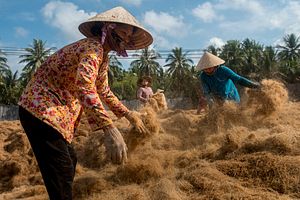Luc Forsyth and Gareth Bright have set out on a journey to follow the Mekong river from sea to source. The Diplomat will be sharing some of the stories they’ve found along the way. For more about the project, check out the whole series here.
The engine had been making odd noises for roughly 20 minutes before the smoke appeared. We had been chugging against the current of the Mekong for more than an hour, trying to reach a family-owned shipyard in the maze-like network of canals surrounding the city of My Tho, and it finally seemed like the boat’s aging motor had given up.
Founded in the 17th century by Chinese refugees fleeing civil war on the mainland, My Tho was once considered the principal gateway to the Mekong delta before losing the title to the much larger and economically more important Can Tho. We had come to My Tho looking for our first insight as to how the river affected people’s lives in an urban context, but after a cursory glance we decided instead to charter a boat to explore the waterways surrounding the city. If ever there was a city symbiotically bound to a waterway, My Tho was it.
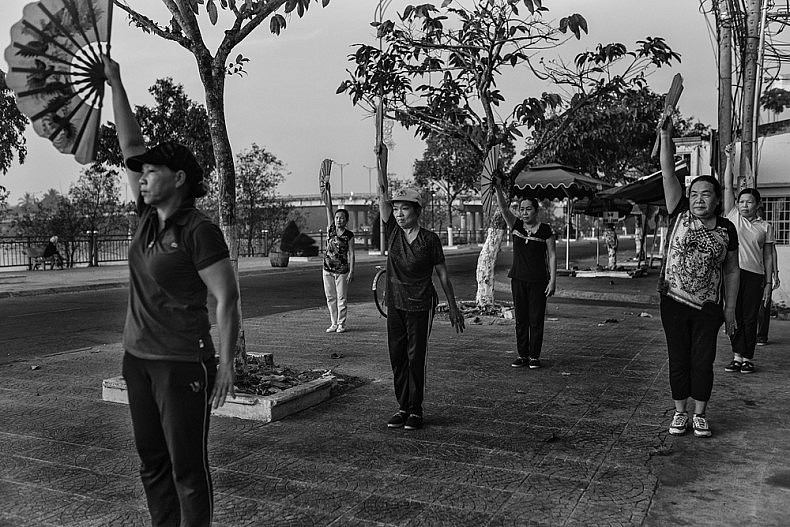
Women perform a traditional fan dance as part of their early morning exercise ritual along the river frontage in Ben Tre, Vietnam. Photo by Gareth Bright.
Happy Accidents
When the boat gave its first signs of ill-health we were well away from the city. First, the water pump quit. The brown, sediment-rich river water slowly seeped into the engine compartment, hissing to a boil as it made contact with the overworked pistons. Acrid yellowish steam issued from the cracks in the floorboards covering the machinery, first in small spurts, and then in great billowing clouds.
The boat driver, who had seemed mostly unfazed by the mechanical difficulties to that point, suddenly sprang into action. Killing the throttle, we drifted in lazy circles while he ran back and forth between bow and stern, checking cables and connections. The ship building yard we were attempting to reach that day was still out of sight upriver and it appeared unlikely that we would be able to fight the current to reach it.
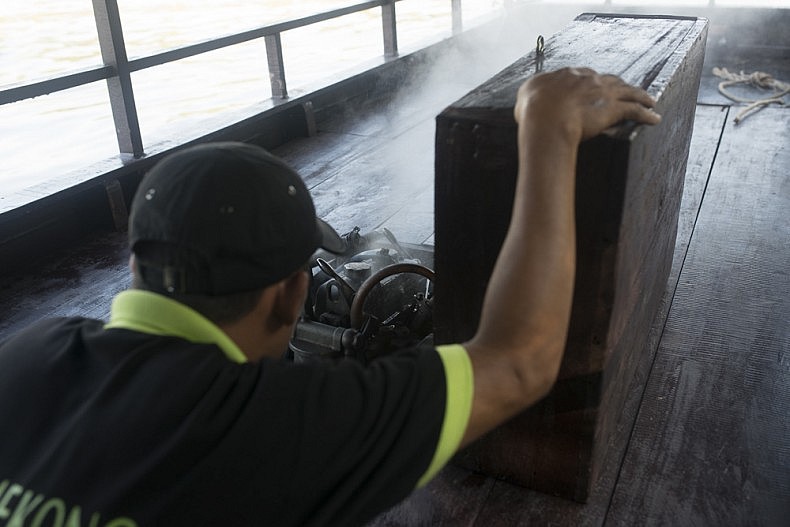
A boat driver attempts to repair the smoking engine of his vessel. Photo by Luc Forsyth.
After conferring with Gareth and Pablo, we made the frustrating decision to turn back, hoping to stumble upon something of interest on our way back to My Tho. We had passed a series of what looked like coconut processing facilities earlier that morning and we hoped that by working with the river’s flow, instead of against it, we could coax the struggling engine into cooperation.
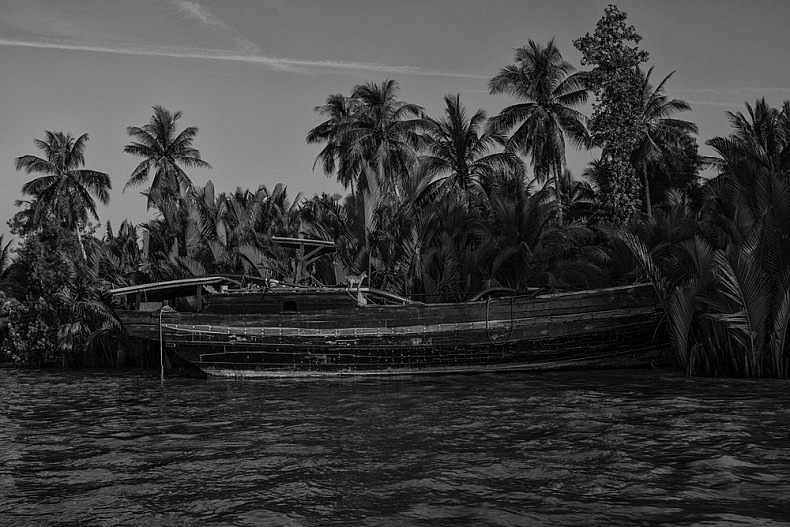
A dog stands guard atop of one the many large boats that act as homes to many of the families in the Mekong Delta’s lush backwaters. Photo by Gareth Bright.
Luckily, as is so often the case with in photography and travel, the unraveling of our initial plans led us to a story we likely would never have found otherwise.
Coconuts, Reimagined
Coconut Island, as locals colloquially referred to My Thanh An, is not actually an island at all. In fact it barely qualifies as a peninsula. But none of us could dispute the inclusion of coconut in the name; what seemed like millions of the green-husked drupes (the proper classificatory family for coconuts, according to Internet biologists anyway) were mounted along the river’s edges to staggering heights.
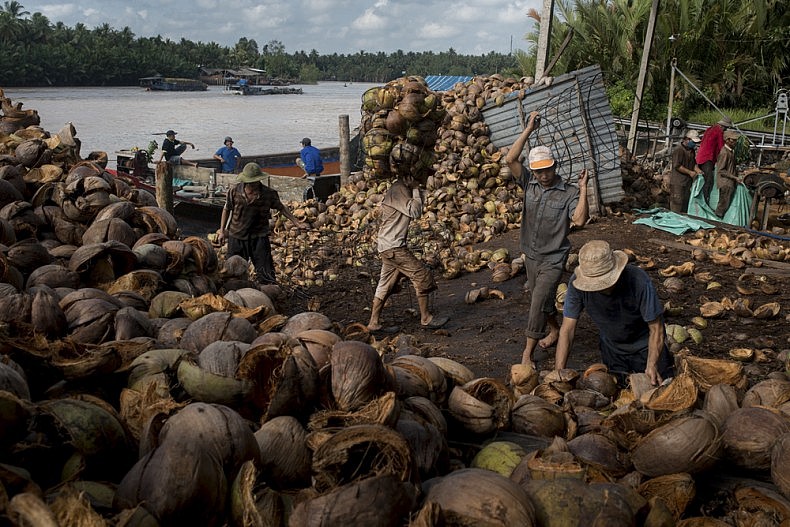
Factory workers load wire baskets with coconut husks and carry them to nearby grinding machines. Photo by Luc Forsyth.
With an abundance of choice as to where to stop, we simply pointed toward one facility at random and asked the boat driver to drop us off. As we approached it was immediately clear that the facility was not built to receive tiny boats like ours, and as a result there was no clear way for us to clamber up the four meter tall cement pad that separated the land from water. Instead we had to awkwardly climb onto a waiting cargo ship, shimmy precariously around its gunnels, and cross a thin, wobbling plank to the shore. While it is often said that the photographer’s dream is to be invisible, at that moment we were anything but. Roughly 30 workers had stopped what they were doing to watch, and I suspected that at least a few of them were hoping for one of us, laden with cameras as we were, to stumble sideways into the water below.
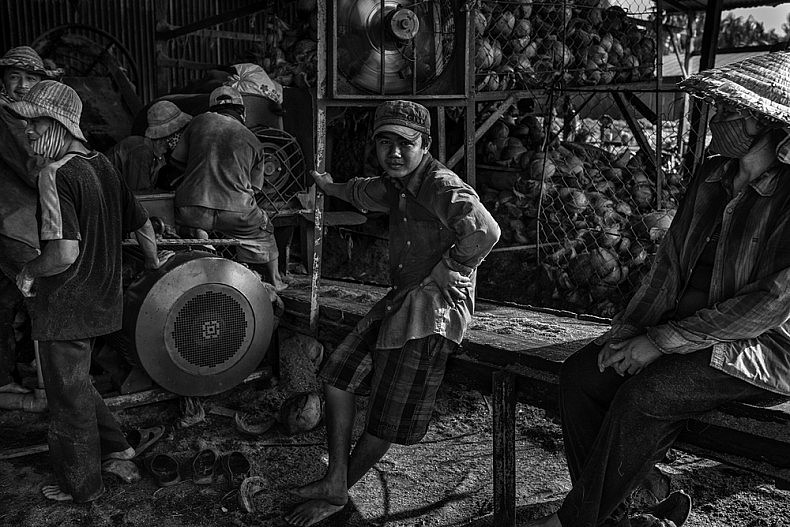
Workers feed coconut husks into a grinding machine. Photo by Gareth Bright.
Ultimately our steps were sure and we made it safely to firm ground, all eyes now turned towards us, wondering what on earth we wanted. Mi, our perpetually hard-working translator, quickly located the operation’s manager who indicated, with a dismissive wave of his hand, that we were free to do what we wanted. The main obstacle now overcome, we were able to finally take in the scene around us.
Contrary to what we were expecting, there were in fact no whole coconuts anywhere on site; only the husks remained, piled densely on top of each other. Teams of sweating men endlessly loaded them into wire baskets, and after hoisting them onto their shoulders, carried them 20 meters over lumpy ground before dumping them into a blue steel hopper. More men waited at the hopper, using pieces of scrap lumber to force the husks into the machine below. Judging from the metallic screeching noises and continual geysers of woody shavings that issued from the machine’s bowels, the coconut husks were ground into fiber.
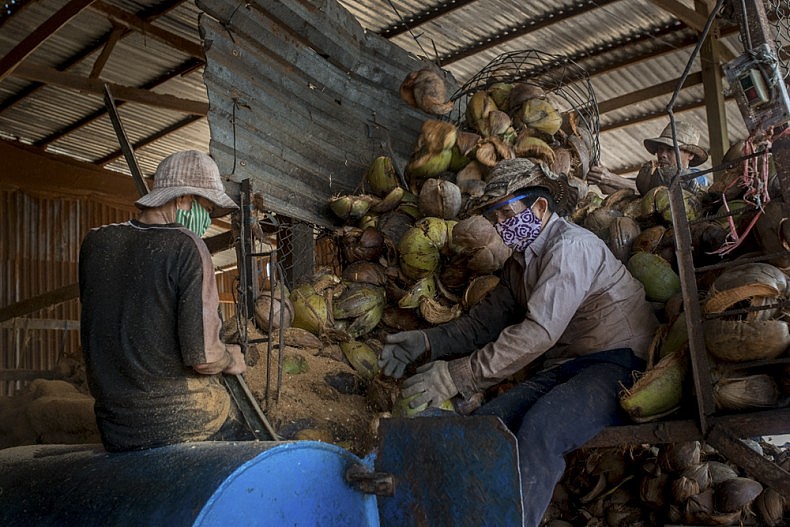
Workers feed coconut husks into a grinding machine. Photo by Luc Forsyth.
A conveyor belt carried the finer of the processed particles out one end of the machine toward men who guided the material into cement bags, filling the 50 kilogram sacks at the rate of one every five minutes. The more substantial strands of husk traveled in the opposite direction, into a spinning steel-mesh tumbler, set at a 30 degree angle to the ground. When enough of the rough hairs built up inside the cylinder, an aged looking woman, hidden under a conical hat and face mask, reached inside and pulled enormous fluffy clumps out with her cotton-gloved hands. After just 15 minutes of being near the machinery my ankles and wrists were chafed terribly against my shirt and socks, itching like fiberglass.
Pairs of women arrived every few minutes with a cloth stretcher, onto which they piled an impressive quantity of the shredded husks before carrying it to a nearby concrete courtyard, at least a hectare in size. There, dozens more women, all identically clad in long-sleeve shirts, face masks, and the ubiquitous Vietnamese conical hats, were hunched over as they separated the wiry strands with their hands. As visually interesting as the operation was, we still had no idea what we were looking at.
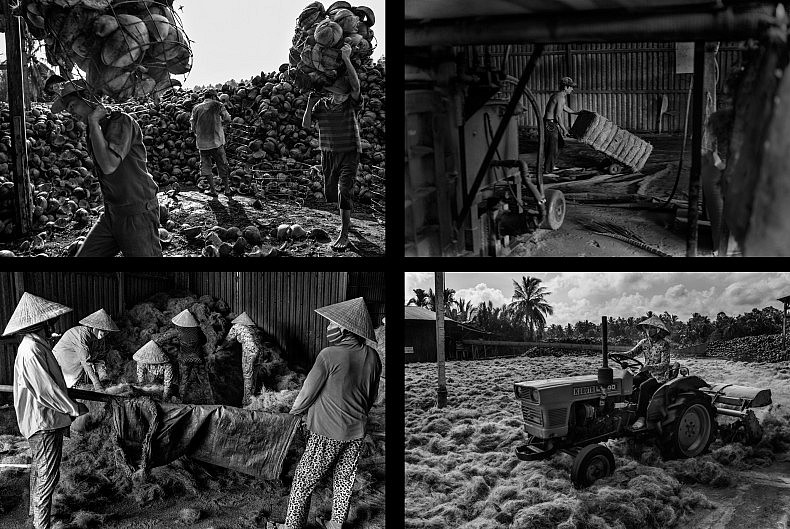
TOP: Factory workers carry the husks of coconuts to the machine (L) and a worker wheels a bale of fibers through the warehouse (R). BOTTOM: Workers gather fibers to take outside to dry in the sun (L) and a worker separates husks with a tractor (R). Photos by Gareth Bright.
It wasn’t until we located the 57-year-old owner of the plant, Nau, that we were able to fully understand. A squat, friendly woman, Nau explained that this was relatively new method of coconut recycling. While the technology had certainly been long since available, it wasn’t until the mid 2000s that the process became commercially viable — mostly owing to an massive increase in demand for flowers in China. The fine dust we had seen stuffed into sacks was loaded onto boats and shipped down the Mekong to distribution centers, which then exported the material internationally as a cheap plant mulch. The longer strands were either woven into mats or used to insulate soundproof walls in recording studios and karaoke bars.
Though perhaps not revolutionary technology, it was nevertheless a clever commercial (and environmental) innovation. A decade earlier, Nau told us, these coconuts would have been considered useless and burned to ashes. Now, the factory employed nearly a hundred people from the island, providing a clean and cheap product for both domestic and foreign markets.
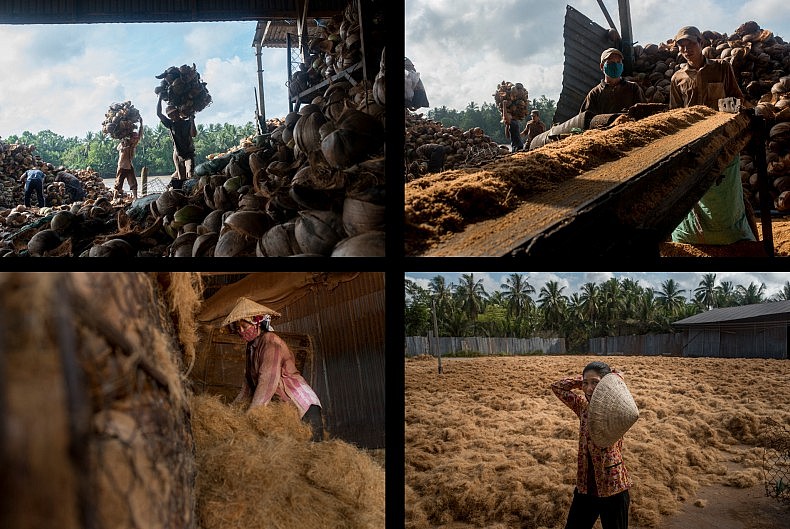
TOP: Factory workers carry the husks of coconuts to the machine (L) and others fill sacks with finely ground husks to be used as mulch (R). BOTTOM: Workers gather longer fibers to take outside to dry in the sun (L) and a woman smiles as she walks by drying coconut husks (R). Photos by Luc Forsyth.
In a single day more than 120,000 hollowed coconuts could be converted into a useful commodity, where before there was only waste. With the region’s coconuts being almost exclusively watered by the Mekong, and all incoming and outgoing shipping conducted by boat along the river, in a very real way flowers on a family table in Shanghai or Kunming might owe their existence to the Mekong.
Not wanting to overstay our welcome, we retraced our steps across the gangplank and scuttled awkwardly back onto our boat. The engine seemingly recovered, we motored back towards the city. From the brink of disasters we had salvaged a fine morning of shooting, and furthered our appreciation of just how far reaching the Mekong’s influence could be.
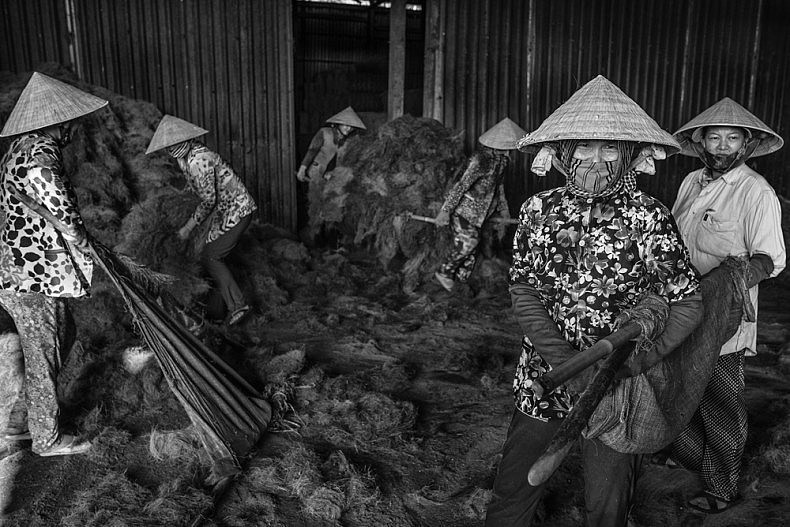
Factory workers gather coconut husk fibers that are carried outside to be dried in the sun. Photo by Gareth Bright.
This piece originally appeared at A River’s Tail.













